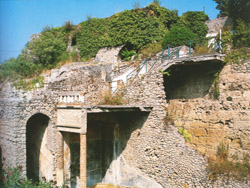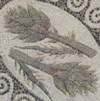
THE IMPERIAL VILLA - POMPEII

This is one of the patrician houses which were built in the shelter of the town walls during the first imperial age. The various rooms of the residence are laid out in terraces descending the natural slope of the hill on which the town of Pompeii was founded and thus enjoy a fine view over the Gulf of Naples. The villa was destroyed by the earthquake of 62 A.D. and was never rebuilt although a number of significant features are still visible today: these include the 80-metre-long colonnade with its 43 columns. Although these are no longer intact, they were originally decorated with white stucco to create a fluted effect and stood out sharply against the rear wall with its black square panels (which were unfortunately removed during the 18th century). The colonnade led westwards into the villa’s residential quarters, which included a large living room and triclinium (measuring 6 metres by 8,80 metres), an alcove with windows looking out to sea, and several other small rooms. The vestibulum and the vault of the living room are embellished with rectangular and octagonal coffered decorations with bas-relief figures and fourth style ornamentation, whilst third style decoration was used for the three walls which are embellished with panel motifs and a frieze of cherubs and vine shoots in the lower section beneath the typical vermillion painted wall and small Greek-style frescoes of figures scenes framed inside niches. The rear wall depicts the legend of Theseus slaying the Minotaur: the left-hand wall portrays Theseus abandoning Ariadne while on the right-hand wall we can see the flight of Daedalus and the fall of Icarus. A series of small paintings with panel doors complete the decoration at the top.





